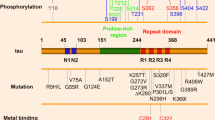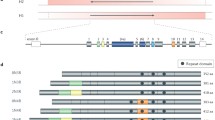Abstract.
Tauopathies are a group of neurodegenerative diseases characterised by intracellular deposits of the microtubule-associated protein tau. The most typical example of a tauopathy is Alzheimer’s disease. The importance of tau in neuronal dysfunction and degeneration has been demonstrated by the discovery of dominant mutations in the MAPT gene, encoding tau, in some rare dementias. Recent developments have shed light on the significance of tau phosphorylation and aggregation in pathogenesis. Furthermore, emerging evidence reveals the central role played by tau pre-mRNA processing in tauopathies. The present review focuses on the current understanding of tau-dependent pathogenic mechanisms and how realistic therapies for tauopathies can be developed.
Similar content being viewed by others
Author information
Authors and Affiliations
Corresponding author
Additional information
Received 3 December 2006; received after revision 23 February 2007; accepted 20 March 2007
Rights and permissions
About this article
Cite this article
Gallo, JM., Noble, W. & Martin, T.R. RNA and protein-dependent mechanisms in tauopathies: consequences for therapeutic strategies. Cell. Mol. Life Sci. 64, 1701–1714 (2007). https://doi.org/10.1007/s00018-007-6513-4
Published:
Issue Date:
DOI: https://doi.org/10.1007/s00018-007-6513-4




